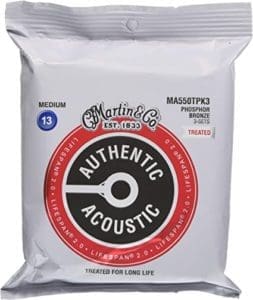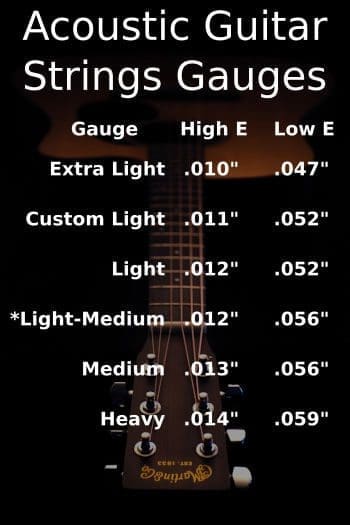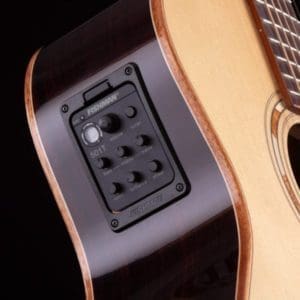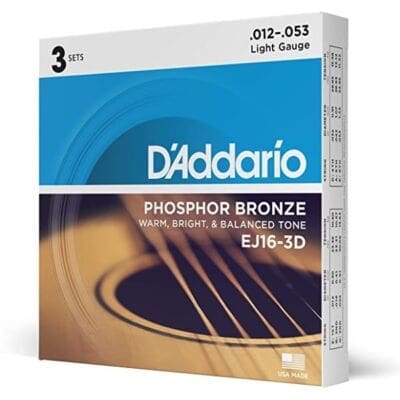Last update 5/2/2024
Acoustic guitars are stringed instruments usually built from wood (tonewoods). The design and materials used will determine the guitar’s overall tone, and for the most part, most of the instrument’s parts are challenging to change, while others are relatively easy to swap out. The most obvious is the guitar strings.
Table of contents
- Classification and Nomenclature of String Gauges
- How String Gauge Impacts Your Tone
- How String Gauge Impacts Your Performance
- Beginners
- Preferred Genres and Playing Styles
- Preferred Tuning
- Your Guitar’s Body Style and Size
- Consider your guitar’s scale length.
- String gauge 10
- String gauge 11
- Guitar string 9 gauge
- Conclusion
One of the most critical factors concerning strings is the string gauge. So, with this in mind, we’ve decided to help you out on how to choose a string gauge for your acoustic guitar. Let’s tackle one thing at a time.


How to choose the correct string gauge
The string gauge is the diameter or thickness of a string set or a particular string. The standard measurement is typically measured in inches or 1/1000th part of an inch.
Although it may seem like not much of a big deal, be aware that a slight difference in diameter can completely change your playing experience and how you approach your instrument.
Classification and Nomenclature of String Gauges
String sets are categorized into five sizes according to their thickness to make things more precise. So, let’s go through each type and take note of the gauge of each string, starting with the High E to the Low E. (thick to thin).
- Extra light: .010, .014, .023, .030, .039, .047
- Custom light: .011, .015, .023, .032, .042, .052
- Light: .012, .016, .025, .032, .042, .054
- Medium: .013, .017, .026, .035, .045, .056
- Heavy: .014, .018, .027, .039, .049, .059
String set categories are named after the diameter of the first (high E) string. For instance, the extra light category can also be referred to as the “10s” (“tens”), while the medium will be “13s” (“thirteens”).
Special note
Be aware that extra light strings are also available for acoustic guitars, like the .009 gauge set in the “extra light” category.


How String Gauge Impacts Your Tone
In acoustic guitars, thicker strings may give you more volume. However, a volume increase is far less noticeable among the thicker gauges. You’ll hear a significant boost going from 10s to 11s, while it won’t be as prominent when going from 13s to 14s.
“As far as guitar picking, if I make the same mistakes at the same time every day, people will start calling it a style.” John Prine
Additionally, thinner strings will sound a bit brighter and “thinner.” Meanwhile, thicker string gauges, like medium or heavy sets, will help you get a more “even” tone, with a more considerable boost in bottom ends and mids.
How String Gauge Impacts Your Performance
The main difference between heavier and light strings is tension and how they feel under your fretting hand fingers. You’ll need to apply more pressure on the heavier strings; bending gets way more complicated with heavier string sets.
It’s also important to note that lighter strings will give you more control over your playing dynamics. Even subtle differences in your playing can be more noticeable when heard with 9s or 10s.
Beginners
It’s generally recommended that beginners start with lighter strings. They’ll be much easier to handle, feel less tension on your fingertips, and have a less painful experience.
One caveat for beginners and very light string sets, 9s, might be tricky when bending; apply too much pressure, and you’ll end up bending them enough to increase the pitch of a note you’re aiming for. Additionally, a high nine-string may feel like a razor blade to some beginners.
The solution is to aim for 10s or 11s if you’re starting.
As you gain more experience, you’ll notice you can play the same things with thicker strings. After a while, try to move on to heavier sets and see how that works for you.
Preferred Genres and Playing Styles


Players with heavier strings usually prefer to hit harder or play “dry” without a PA system.
This is useful for classic rock, folk, country, and blues music.
However, if you’re playing chords most of the time, then medium or heavy strings are the way to go.
Lighter strings are mainly intended for lead players and use their acoustic guitar’s integrated electronics to go directly into a PA system.
Although quieter, they can be handy for lead playing because they allow easier bending, vibratos, and dynamic control.
They’re also helpful for rhythm players with a preference for lighter picks.
Preferred Tuning
Thicker strings result in more string tension. Your .010 set will feel nothing like .013 or .014 sets. But if you go with lower tunings, you’ll notice that lighter strings can feel like rubber and even affect tuning stability.
The general rule is that you’ll need thicker strings for lower tunings, like standard D, standard C, drop C, and others. Meanwhile, all good quality string sets can be used for the standard E tuning, although heavier sets will add more tension.
Your Guitar’s Body Style and Size
While it’s not a super-strict rule, manufacturers will often recommend lighter strings for smaller guitars and cutaway models. On the other hand, guitars with larger bodies could use heavier sets to get more volume and resonance.
Therefore, guitars with OM, 000, 00, or 0 body shapes would go better with lighter strings. Meanwhile, larger instruments like Jumbo or Grand Jumbo acoustic guitars might work better with heavier sets.
Consider your guitar’s scale length.


It’s essential to consider your guitar’s scale length (the distance between the nut and the bridge). Shorter scale lengths, ranging from 22.5 to 24.5 inches, will have less tension, so you can use thicker strings, especially for lower tunings.
Conversely, guitars with longer scale lengths, going from 25.5 to 27 or more inches, will have more string tension, so you could try lighter strings to ease things up, even with some lower tunings.
String gauge 10
10 gauge strings are a popular choice for electric guitarists because they offer a good balance of tone and playability. They are thicker than 9 gauge strings, which gives them a fuller sound and more sustain. However, they are still thin enough to be relatively easy to bend and fret. 10 gauge strings are good for various genres, including rock, blues, and jazz.
String gauge 11
11-gauge strings are thicker than ten-gauge strings, which gives them a fuller sound, more sustain, and more brightness. They are also more durable than thinner strings, which can be helpful for heavy strummers and aggressive players. However, 11 gauge strings can be more difficult to bend and fret, so they may not be the best choice for beginners. 11 gauge strings are a good choice for various genres, including rock, metal, and country.
Guitar string 9 gauge
9 gauge strings are the thinnest type of guitar string commonly used on electric guitars. They are easy to bend and fret, making them a good choice for beginners and players who like to play solos. However, they have a thinner sound and less sustain than thicker strings. 9 gauge strings are a good choice for various genres, including pop, funk, and blues.
Conclusion
Yeah, we have all these rules to consider. But at the end of the day, the choice comes down to you. After all, there are as many playing styles as guitar players. So, the best way to find the perfect string gauge is to try them all out, possibly on your preferred type of acoustic guitar.
You can experiment with how a heavier or lighter set of acoustic guitar strings works with your preferred instrument and playing style. Maybe medium or heavy strings might work better for you, even if you’re a lead player.
However, bear in mind that these rules can make your life easier. Sticking to them can help you achieve a better tone and a more effective performance.
Transparency disclosure: Some of the links in this post are affiliate links, meaning that I may earn a commission if you click on a link and make a purchase. This commission comes at no extra cost to you. We only recommend products and services that I believe are helpful and valuable, and we never let the potential for a commission influence our recommendations.
Amazon guitar strings



